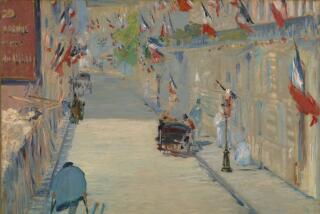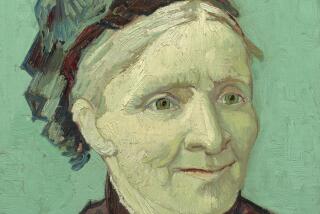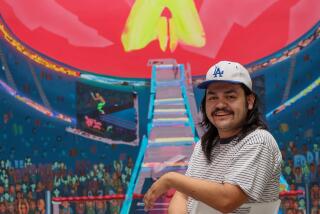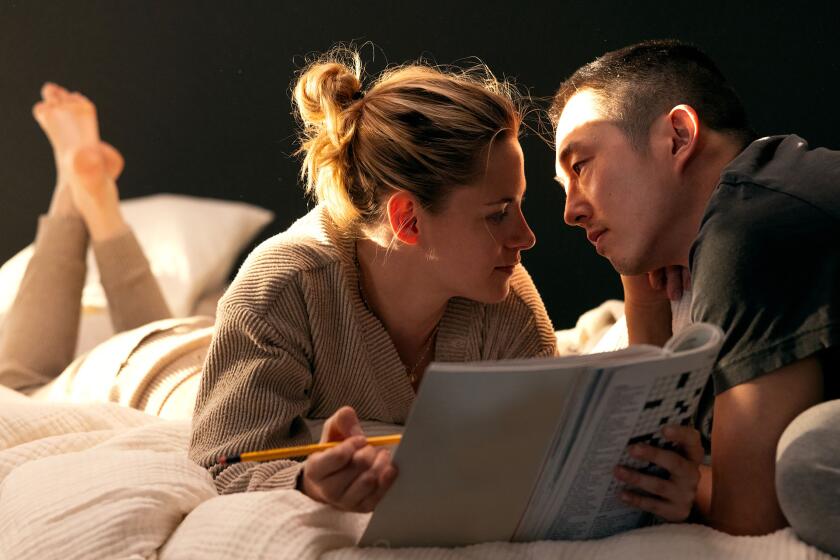TRAVELING IN STYLE : NIGHTHAWKS & BROWNSTONES : New York Has Changed Dramatically Since Painter Edward Hopper Portrayed It, But Traces of a Hopper-esque Past Endure
- Share via
EDWARD HOPPER--THE QUINTESSENTIAL REALIST PAINTER OF 20th-Century America and an artist who has been extremely influential in many areas of American popular culture--began his long acquaintance with New York City in 1899, when he first arrived there at age 17 from his home just up the Hudson in Nyack. He spent seven years in New York art schools, then made three trips to Europe before settling down in 1910 back in New York, where he lived until his death in 1967.
New York in 1899 was in transition from a 19th-Century city to a modern metropolis with the new skyscrapers that became its trademark. The growing city bustled with palpable excitement. Hopper preferred the smaller row houses and other remnants of an older, more familiar way of life, but he was also attracted to the lively theaters on Broadway, the rowdy burlesque shows and inexpensive luncheonettes and second-floor Chinese restaurants. And he painted the city’s automats, movie palaces, theaters, offices, apartments and cheap hotels with such austerity and conviction that his views of them seem to embody the very character of modern cities. Most of the sites that inspired him have vanished, the city’s last remaining automat closing only a few years ago.
One painting more than any other has caught the world’s imagination and symbolizes Hopper’s New York: “Nighthawks,” his masterpiece of 1942 (which now hangs in the Art Institute of Chicago). The all-night diner with its four lonely figures has long since attained the status of an icon of 20th-Century urban life. Contemporary artists, designers and cinematographers regularly appropriate the painting. “Nighthawks,” Hopper once noted, “was suggested by a restaurant on Greenwich Avenue where two streets meet.” The vintage eatery he painted has not survived, but an unusual triangular spit of land in Greenwich Village, where Greenwich and Seventh avenues meet Eleventh Street, suggests the original site.
According to Hopper, another of his best-known paintings, “Early Sunday Morning” (1930), depicted a scene nearby, in the same neighborhood. With its prominent barber pole standing in front of heavily corniced row houses with shop windows on the ground floors, the site was reportedly found on lower Seventh Avenue. But many a Brooklynite thinks he has spotted a similar street in Park Slope or Brooklyn Heights.
Hopper moved to Greenwich Village in 1913 and made it his home base. He came to know the area especially well and found many of his subjects there. Yet he branched out tirelessly throughout the city, finding sites to portray all the way from Manhattan Bridge on the Lower East Side up to 155th Street in Harlem, where he sketched Macomb’s Dam Bridge on the Harlem River for a 1935 painting.
For 54 years, until he died, Hopper lived on the top floor of 3 Washington Square North. The building was once a haven for artists and writers, from John Dos Passos to Rockwell Kent to William Glackens. Today, it is the offices of New York University’s School of Social Work. Had Hopper lived in Europe, his house would surely be a museum, but in this diffident and blase American metropolis, there’s not even a plaque on the building’s exterior.
AWARENESS OF HOPPER IS GREATER WHERE THE ARTIST GREW UP, 40 MILES UP the Hudson River in Nyack. Some citizens of this once-sleepy town raised funds to restore Hopper’s boyhood home, which had been built by the artist’s grandfather in the mid-19th Century (see Guidebook). Hopper continued to visit the house all his life, since his sister lived there until she died. Although there are no original Hoppers on view, the house is quite evocative of his painting. His canvas “Summer Evening” (1947) presents a once-romantic couple squabbling on a porch that has a layout quite like that of his boyhood home. And in 1949, he painted a view he had cherished all his life, looking down the house’s central staircase and out the doorway toward the Hudson River.
Even after Hopper left Nyack, he never lost his love of rivers and nautical life. Some of his first paintings of New York depict scenes along the East River--”Blackwell’s Island,” “Queensborough Bridge” and “East River.” If Blackwell’s Island, now called Roosevelt Island and much changed by modern housing, is unrecognizable today, the Queensborough Bridge at 59th Street, then a new engineering marvel, looks much the same as it did in 1913 when Hopper painted it. On an overcast day, the East River still turns the same soft blue-gray that the artist caught in his canvas.
In 1925 and 1926, Hopper depicted New York in watercolors. He made several views of the Manhattan Bridge, including one of the triumphal arch that defines its elaborate entranceway. At home, “Skyline Near Washington Square,” “Skylights” and “Roofs of Washington Square” all focused on sights seen from the roof of his own studio. New York’s characteristic chimney pots, skylights and rooftop water towers can still be seen throughout the city today, and the visitor in search of Hopper’s New York need only look up to find shapes like those that fill these views out windows in such paintings as “Morning Sun” (1952).
His success in painting New York in watercolor soon led Hopper to treat similar subjects in oil. In “The City” (1927), he portrayed a corner of Washington Square, where his beloved row houses appear to be fending off encroaching skyscrapers. In 1932, he painted “November,” “Washington Square” (the view south from his studio) and “City Roofs” (looking east from his own roof). Most of the architecture then visible from Hopper’s studio window has changed. Today, besides the Washington Square Park itself, all that recalls what he painted is the Judson Memorial Baptist Church, with its amber-colored square tower topped by a cross.
HOPPER WAS DISMAYED AT the new construction taking place around the square. In the more than five decades that he lived adjacent to it, New York University moved in and replaced many of the old row houses with tall new buildings. Other urban development soon filled up the skyline beyond. Nonetheless, as late as 1960, Hopper, who often sat in the park to soak up some sun, was inspired there to paint “People in the Sun,” a canvas he then set in an imaginary Western landscape.
The observant pilgrim in search of Hopper’s New York will delight in the massive city stoops with their heavy masonry and hefty cornices that figure in paintings such as “New York Pavements” (1924) and “Sunlight on Brownstones” (1956), which the artist based on the well-preserved brownstones in the west 80s near Central Park. Always interested in architecture, Hopper once claimed the magazine editors wanted him to illustrate people “grimacing and gesturing” while “what I wanted to do was to paint sunlight on the side of a house.”
Across town in the east 80s, some colorful remnants of Hopper’s era remain. Though not the same establishment that suggested “Drug Store” (1927), Lascoff’s Pharmacy is of the same genre and has been at the corner of Lexington Avenue and 82nd Street since 1931. Just one block north, across the avenue on the corner of 83rd Street, the Lexington Luncheonette is so evocative of the period that it is frequently chosen as a location for period films.
Of the theaters Hopper frequented so enthusiastically, only the now-shuttered Republic Theater on West 42nd Street, where he watched burlesque performances in preparation for his canvas “Girlie Show” (1941), still stands. Hopper sketched what he wanted of the architecture here, then came home and had his 58-year-old wife, the artist Josephine Nivison Hopper, pose for the striptease dancer. (The Republic is being restored and is scheduled to reopen next year as the New Victory Theater.)
Central Park, which also provided Hopper with material, looks much the same as it did when he represented it. In 1935, he painted “Shakespeare at Dusk,” featuring a monument to the bard, located on the Mall just north of the Children’s Zoo at 66th Street, against the backdrop of a menacing skyline. The mood of melancholy at sunset that Hopper captured endures.
Four years later, another Central Park scene inspired Hopper’s “Bridle Path.” Three equestrians are about to pass through the dark foreboding space beneath a bridge (near 72nd Street on the park’s western edge). Today, riders continue to enjoy the park’s six miles of bridle paths: Claremont Riding Academy, a stable at 175 West 89th St., still has horses available for riding through the park.
Hopper especially enjoyed searching for subjects from the “El” (elevated train). He eagerly peeped into apartments and lofts along the route, finding inspiration for such paintings as “Night Windows” (1928), “Office at Night” (1940) and “Conference at Night” (1949). The last El trains were demolished during the 1950s, but anyone wanting to experience the “Hopper effect” can take Metro North trains from Grand Central Station north. After leaving the tunnel at 96th Street, one can peer into buildings along the tracks.
The point where the trains go underground between 96th and 97th streets on Park Avenue inspired Hopper’s 1946 canvas “Approaching a City.” Hopper claimed that he wanted to convey “interest, curiosity, fear--the emotions one has arriving by train into a strange city.” The tracks bordered by high-rise buildings along upper Park Avenue through Harlem attracted the painter, who had adored railroads since boyhood and had often made trains a theme of his pictures. “To me,” he once remarked, “the most important thing is the sense of going on.”
GUIDEBOOK: Hopper’s New York
Seeing Hopper’s paintings: Excellent examples of the artist’s work, including scenes of New York, are usually on view in Manhattan at the Metropolitan Museum of Art, 5th Avenue at 82nd Street, (212) 879-5500; the Museum of Modern Art, 11 West 53rd St., (212) 708-9400; the Whitney Museum of American Art, 945 Madison Ave., (212) 570-3676 and The Brooklyn Museum, 200 Eastern Parkway, Brooklyn, (718) 638-5000. The Whitney received a huge bequest of Hopper’s works from the artist’s widow in 1968. Although Hopper enthusiasts will be disappointed to find that the Whitney only occasionally puts a small selection of this bequest on view, the museum has scheduled a major Hopper show for next summer.
Hopper’s Home: The Hopper House Landmark Preservation Foundation, 82 N. Broadway, Nyack, (914) 358-0774, offers art classes and exhibitions by artists. The center is open 1 to 5 p.m., weekends only; admission is free, but a donation of $1 per person is suggested.
More to Read
The biggest entertainment stories
Get our big stories about Hollywood, film, television, music, arts, culture and more right in your inbox as soon as they publish.
You may occasionally receive promotional content from the Los Angeles Times.










